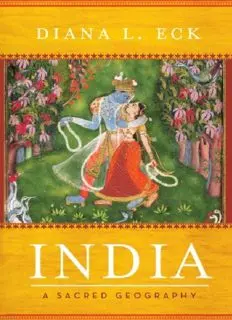
India: A Sacred Geography PDF
Preview India: A Sacred Geography
Copyright © 2012 by Diana Eck All rights reserved. Published in the United States by Harmony Books, an imprint of the Crown Publishing Group, a division of Random House, Inc., New York. www.crownpublishing.com Harmony Books is a registered trademark and the Harmony Books colophon is a trademark of Random House, Inc. Library of Congress Cataloging-in-Publication Data Eck, Diana L. India : a sacred geography / by Diana L. Eck.—1st ed. p. cm. 1. India—Religion. 2. Sacred space—India. 3. Hinduism—India. I. Title. BL2001.3.E25 2011 294.50954—dc22 2011009237 eISBN: 978-0-38553191-7 All photos courtesy of the author, except this page, courtesy of Asian Art Archives, Univ. Michigan (AAAUM), and this page, Krishna Lifting Mount Govardhan, attributed to Mola Ram (1760-1833) Maps by C. Scott Walker, Digital Cartography Specialist, Harvard Map Collection; map, this page, by Michael Gellatly Jacket design by Nupoor Gordon Jacket painting: Detail of Radha and Krishna Walking in a Flowering Grove (recto) © The Metropolitan Museum of Art, Image source: Art Resource, NY v3.1 TO DOROTHY ECK AND DOROTHY AUSTIN THE TWO DOROTHYS, BOTH GIFTS OF GOD C ONTENTS Cover Title Page Copyright Dedication Note on Transliteration and Pronunciation 1 A S G , A I L CHAPTER ACRED EOGRAPHY N MAGINED ANDSCAPE 2 “W I I ?” CHAPTER HAT S NDIA 3 R A I : I L W CHAPTER OSE PPLE SLAND NDIA IN THE OTUS OF THE ORLD 4 T G R I CHAPTER HE ANGĀ AND THE IVERS OF NDIA 5 S L L I CHAPTER HIVA’S IGHT IN THE AND OF NDIA 6 S D B G CHAPTER HAKTI, THE ISTRIBUTION OF THE ODY OF THE ODDESS 7 V , E D CHAPTER ISHNU NDLESS AND ESCENDING 8 T L S K CHAPTER HE AND AND TORY OF RISHNA 9 F R : T R L I CHAPTER OLLOWING ĀMA HE ĀMĀYANA ON THE ANDSCAPE OF NDIA 10 A P I T CHAPTER ILGRIM’S NDIA ODAY Acknowledgments Glossary Bibliography Notes N T OTE ON RANSLITERATION AND P RONUNCIATION While Sanskrit is said to be the “perfectly made” and polished speech of the gods, those of us who are mortal and write in English have to simplify the transliteration for ease of reading. In this book, I have kept diacritical marks to a bare minimum, using only the long mark, or macron, important for the proper pronunciation of short and long vowels. a (as allow: Shiva) ā (as in father: Kāshī) i (as in it: linga) ī (as in magazine: devī) u (as in put: Upanishad) ū (as in rude: Chitrakūt) For consonants, I have written both the retroflex “s” (with a dot under it as in Vi⋅nu) and the palatal “s” (with an accent mark as in Śiva) as “sh,” since this is basically how they are pronounced. Other distinctions in this precisely articulated language have also been lost here. Aspirated consonants (those followed by an “h”) are pronounced as follows: “bh” as in clubhouse, Bhagavad Gitā; “dh” as in roundhouse, dharma; “th” as in hothouse (tīrtha). Two-syllable words are usually accented on the first syllable: Shiva, Vishnu, dharma. In words of more than two syllables, the penultimate syllable is accented if it contains a long vowel (Vishvanātha, Purāna) or a dipthong (Kurukshetra). Otherwise, the accent is on the antepenultimate (third from last) syllable, as in Ramāyana, Mahabhārata, Amarakantaka, Rāvana, Lakshmana. Another issue is that of Sanskrit and Hindi transliteration. The most noticeable difference between Sanskrit and Hindi words is the presence of the final short “a” in Sanskrit and its absence in Hindi. For example, darshana (“seeing” the divine image) becomes darshan in Hindi, Ganesha becomes Ganesh, Prayāga becomes Prayāg. I have not chosen one form exclusively over the other, but have tried to be consistent to the context. For example, if the reference is to a Sanskrit text, I might use Somanātha, but on the whole I have kept the form in which these words are most easily recognizable today, which would be Somnāth. (Similarly, Badrīnāth rather than Badarīnātha, Hardvār, rather than Haridvāra, Chitrakūt rather than Chitrakūta.) Even when I switch back and forth, the reader will soon adjust to the fact that this is simply the complexity of an ancient, yet modern, culture. Finally, we should note that so many of the major cities of British India have now claimed official Indian names: Mumbai rather than Bombay; Chennai rather than Madras; Kolkata rather than Calcutta; Tniruvananthapuram, rather than Trivandrum. I have used both forms, since both are still in common parlance. I have not used diacritical marks on cities, states, common mountain ranges, or other geographical features, with the exception of rivers.
